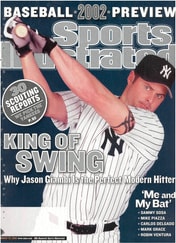
The Big Stick It has taken an overhauled stance--and gobs of extra-thick pine tar--to turn Arizona's Luis Gonzalez from spray hitter to feared slugger
The only thing his Arizona Diamondbacks teammates dislike about
Luis Gonzalez is his pine tar. He's partial to a particularly
heavy, gummy brand that's meant for fastening horseshoes to
hooves. The tar makes his bat so sticky, it's a wonder he can
drop it without first having surgery. Some of the Diamondbacks
hate the substance so much that they treat Gonzalez's bats as if
they were infected. They even made him get his own bat bag
because the tar was finding its way onto their wood.
Even though it's goo, it's Gonzo's goo, which gives it a certain
cachet. Says Arizona third baseman Matt Williams, who tried the
pine tar before deciding it was just too much like glue, "It's
bad stuff, but you look at the results that Gonzo's gotten the
last few years, and you figure it's at least worth a shot.
Whatever he's doing is obviously working."
Before joining the Diamondbacks, before the 1999 season,
Gonzalez batted .300 only once and never had more than 23 home
runs in any of his eight full major league seasons with the
Houston Astros, the Chicago Cubs and the Detroit Tigers. Since
then he has hit .324 and averaged 38 homers and 122 RBIs. Last
year, during which he would have made more headlines if Barry
Bonds hadn't made history, Gonzalez batted .325 (10th in the
National League), whacked 57 homers (third), drove in 142 runs
(third), had a .688 slugging percentage (third) and amassed 419
total bases, which was second to the 425 of the Cubs' Sammy Sosa
and tied Gonzalez with Lou Gehrig (1930) for the 10th-highest
single-season total in major league history. The
lefthanded-hitting Gonzalez capped his year with a bloop single
off New York Yankees closer Mariano Rivera in the bottom of the
ninth inning of World Series Game 7--the hit that scored Jay
Bell to give the Diamondbacks a 3-2 win and their first
championship.
There is no single reason for the 34-year-old Gonzalez's
late-career improvement, not even his trademark open batting
stance, in which he sets his front foot far away from the plate,
as if he were trying to get a head start on the walk back to the
dugout. "People tend to think it's the stance, and that's
certainly been a big part of it," he says, "but what's happened
the last few years really came about because of a lot of
factors, both physical and mental." His transformation from a
journeyman into one of baseball's premier power hitters is the
result of listening to good advice, working diligently to make
radical and subtle adjustments, and having a run of good fortune.
The luck came first, before the 1998 season, when Gonzalez
signed as a free agent with Detroit. His metamorphosis might
never have happened if he hadn't played that one season in Tiger
Stadium. One of his teammates, outfielder Bobby Higginson,
watched him spray balls around the park every day in batting
practice, with Gonzalez all but ignoring the overhanging
rightfield porch that was only 315 feet away.
"He had these quick hands and wrists," says Higginson. "I just
told him he ought to think about trying to hook the ball a
little more, because he was obviously capable of putting some
more balls in those rightfield seats." Gonzalez began working on
rotating his hips more in order to turn on pitches, and he
finished with 23 homers, eight more than he'd hit in his
previous best season.
Still, Gonzalez wasn't completely satisfied. If he was going to
take full advantage of the short porch, he needed to handle
inside pitches better. He had always been a so-called dive
hitter, one who takes a big stride toward the plate to make sure
he can reach pitches on the outer half of the strike zone. That
enabled him to knock outside pitches to left and left
centerfield, but he was often tied up by fastballs that bore in
on him.
"The pitcher's idea with guys like Gonzo who dive across the
plate is to jam them," says Diamondbacks hitting coach Dwayne
Murphy. "Suddenly they're swinging with short arms, and they
can't generate any power." So in the last month of the 1998
season Gonzalez began experimenting with his stance, dropping
his right foot away from the plate to keep from getting jammed.
He was encouraged by the results, but Detroit apparently wasn't:
It traded him to Arizona after the season for outfielder Karim
Garcia, who has since played a total of 132 games for three
clubs, batting .235. The Diamondbacks had to throw in $500,000
to close the deal, one of the biggest steals in recent memory.
In his first spring training with Arizona, Gonzalez made his new
open stance even more pronounced. He set his front foot farther
from the plate and turned his back foot slightly in toward the
pitcher, which kept him from diving at pitches. It made him look
a little like a man trying to hold his ground in a stiff wind,
but there was no doubt about whether it worked--Gonzalez started
the season with a 30-game hitting streak. "The key for Gonz, and
for most hitters, is getting his arms extended on his swing,"
says Murphy. "Now he's getting great extension whether the
ball's in or away. Pitchers still try to bust him inside and get
him to make those arms short, but he's so quick inside that it's
almost impossible to do."
Since there is no longer a location that is a particular
weakness for Gonzalez, the plan of attack against him usually
involves changing speeds. He kicks his front leg high before he
swings, a timing mechanism that pitchers try to disrupt with
off-speed pitches. When Gonzalez slumps, it's usually because
the strategy is working and he has started to lunge at those
deliveries.
The 6'2" Gonzalez has gradually bulked up from 180 to 195 pounds
since he began working with a personal trainer, in 1996. But
even before he added muscle, teammates and coaches looked at his
quick, strong hands and wrists and saw the makings of a power
hitter. When Gonzalez was with the Astros, Yogi Berra, then a
Houston coach, told him he should use a heavier bat than the
34-inch, 32-ounce model he was swinging, and Gonzalez eventually
moved up to the 34/33 that he uses today. "That may not sound
like a big deal," says Murphy, "but when you generate the kind
of bat speed Gonzo does, an extra ounce can make a real
difference."
A simple regimen allows Gonzalez to maintain those quick wrists
and that bat speed. His pregame routine consists of "flips," in
which the kneeling Murphy softly tosses balls in the air for
Gonzalez to hit into a net. "He'll only take about 15 or 20, and
then he'll say, 'O.K., I'm good,'" Murphy says. Then Gonzalez
takes batting practice. "In the first round of swings I just try
to go the other way," he says. "After that I just take my hacks.
I'm not one who gets in the cage and thinks about where I'm
holding my hands or whether I'm keeping my shoulder in. Once I'm
in the box I just try to let my instincts and reactions take
over."
It hasn't always been that way. Early in his career Gonzalez
constantly analyzed every aspect of his hitting--his swing, his
stance, his hands, his hips. "I beat myself up and drove myself
crazy," he says. "I took tapes home and studied myself over and
over. I tried every stance, spread out, crouched, stood tall,
everything. When you get older, you realize that sometimes it's
the thinking that gets you into trouble and you're better off
keeping it simple." The stripped-down approach wasn't just a
choice, it was a necessity. Luis and his wife, Christine, are the
parents of three-year-old triplets--Alyssa, Jacob and Megan--and
when Luis walks in the door, there's no time to obsess about
whether he's keeping his bat flat through the hitting zone.
Although Gonzalez insists he simply does what comes naturally at
the plate, his careful advance preparation allows him to relax
once he steps into the box. He doesn't study himself much on
video, but he scrutinizes footage of opposing pitchers. When he
comes up to bat, he's thinking about the pitcher's release point
and what the pitch is likely to be. He also has a routine he
follows as he enters the batter's box. He draws a line with his
bat near the front of the box, a boundary that his front foot is
not to cross when he strides forward. After he takes a practice
swing or two, he puts his bat out in front of him, visualizing
where he wants to hit the ball. Then he steps into the box and
takes a couple of half swings, thinking about bringing the bat
through the same plane that the ball will be on. He envisions a
line drive before he hits it.
Gonzalez obsesses less about his technique than his tools: his
bats, which until now have been made-to-order Rawlings 256Bs.
(Gonzalez recently signed a contract with Easton, which will
begin supplying him later this season.) Once the bats arrive from
the factory, they're treated according to Gonzalez's exacting
specifications, which means the right amount of his beloved pine
tar must be placed in precisely the right spot. There's only one
man Gonzalez trusts to perform that task--Arizona home clubhouse
attendant Shawn Moore. "He's my bat guru," Gonzalez says. "He
tars them up and then resins them down so they're nice and tacky.
It's a skill." Moore also knows that Gonzalez will swing no bat
before its time, so once the tar is applied, the bats sit for a
week, until the tar has the right consistency.
When Moore thinks a batch of bats is ready, he brings Gonzalez
into the bat room at Bank One Ballpark to inspect it. When
Gonzalez finds a bat he likes, he puts an X or a star on it, and
the bat goes into the rack in the dugout. Says Moore, "When I
see him crush one with a bat that I tarred up for him, I like to
think that maybe I helped him just a little bit."
On a recent morning Gonzalez held one of his carefully prepared
bats as he took flips from Murphy. He hit ball after ball
squarely, sending them whizzing into the net. After about a dozen
he held up his hands. "That's enough," he said. "I'm good." That
wasn't quite true. Gonzalez used to be good. Now he's great.
COLOR PHOTO: PHOTOGRAPH BY V.J. LOVERO Very tacky The gooey Gonzalez entrusts clubhouse man Moore with the sticky task of tarring his bats.
COLOR PHOTO: TOM DIPACE Then and now As an Astro in 1993 (far left), Gonzalez already used an open stance; widening it farther has given him more extension on his slashing swing.
COLOR PHOTO: JOHN W. MCDONOUGH [See caption above]
"When you get older," says Gonzalez, "you realize that sometimes
it's the thinking that gets you into trouble."

